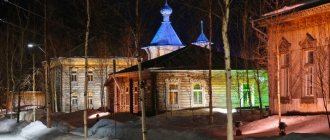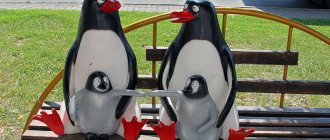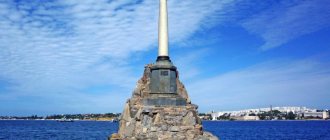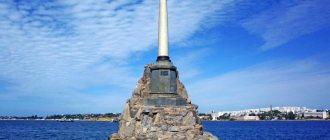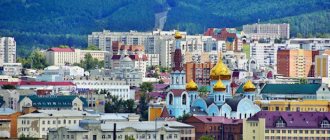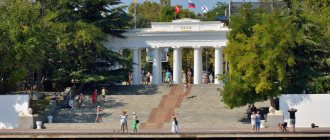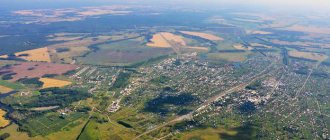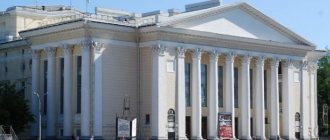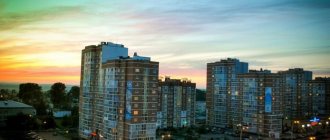Monument "Memory of Miners"
It is difficult to imagine the main city of Kuzbass without monuments to miners. Kemerovo is the coal capital of the region. That is why a monument dedicated to representatives of this industry appeared in the city. The author of the monument is Ernst Neizvestny.
The history of the creation of the monument is remarkable. We have long wanted to celebrate the importance of miners’ work. This issue was first discussed in 1969 by the Council of Ministers. The name of the monument had already been thought up, and the sketches were ready. But it was not possible to implement the plan. The situation changed only several decades later. Then the governor of the region, Aman Tuleyev, first met with the Unknown, whose works had already been installed not only on the territory of the Russian Federation, but also in ten other countries of the world.
Initially, the monument was conceived as a mournful reminder of the miners who died in the mines of Kuzbass. But Ernst Neizvestny defined the theme of the work a little differently. He said that the main idea that the composition carries is resistance and heroism. After all, it is selfless labor, equated to military work, that distinguishes miners from specialists in other industries.
The opening of the monument took place in 2003 right on Miner’s Day - August 28. The installation location was chosen by the author. Ernst decided that the best place for his creation was Red Hill. By the way, the sculptor came to Kemerovo from New York to take part in the opening ceremony.
Where to go for tourists in Kemerovo, interesting places
What to visit in Kemerovo for those vacationers who are attracted by cultural attractions? First of all, you should familiarize yourself with the various museum exhibitions and theatrical performances. Where can those who want to relax go for a walk? They can walk along the alleys of parks or go to a shopping and entertainment center.
Museum of Local Lore
One of the oldest museums in the Kemerovo region. Founded in 1929. The museum has over 100 thousand exhibits dedicated to the history and natural resources of the region. Those interested can look, for example, at the largest paleontological collection in Russia, which represents the remains of fossil animals.
Address: ave. Sovetsky, 51.
Opening hours: 10:00-19:00 (closed on Monday).
How to get there: trolleybuses 1, 7, buses 23, 54, 168.
Get directions
Art Museum
Initially functioned as an art gallery (1969-1991). Now the museum annually holds about 50 exhibitions, which present works from private collections, funds of other museums, as well as its own exhibits, of which there are more than 5 thousand. Visitors are invited to appreciate the paintings of artists who worked at the turn of the 18th and 19th centuries, admire sculptures and works of decorative and applied art.
Address: ave. Sovetsky, 48.
Opening hours: 10:00-19:00 (except Mondays).
How to get there: buses 1, 15.
Get directions
Drama theatre
Since the first season (1934), the theater has not had its own building. It appeared only in 1961. Now it is a luxurious building with columns, where domestic and foreign classics and children's plays are staged. Guests have the opportunity not only to watch the performance, but also to visit the museum located on the territory of the theater.
Address: Vesennyaya, 11.
Opening hours: performances run from Tuesday to Sunday (11:00, 14:00, 18:00, 19:00).
How to get there: trolleybus 1, 7, 15, minibus 4t, 5t.
Get directions
Museum "Red Hill"
You should definitely visit the museum-reserve, built on the site of a coal mine. Visitors can visit a real mine, where the atmosphere of the last century has been recreated. The observation decks offer panoramic views of the city. Where to go on the museum grounds? The sculpture “Memory of the Miners of Kuzbass” was erected here, and production equipment used in coal mining was installed. Public events and theatrical performances are also regularly held.
Address: Krasnaya Gorka, 17.
Opening hours: 10:00-17:30 (daily).
How to get there: by buses 23, 54.
Get directions
Park of Miracles
The most popular holiday destination for the whole family. The park has been operating for more than 80 years. On its territory there are many attractions, sports grounds are equipped, cafes are opened, and performances by artists are organized. Soso Pavliashvili and the group “Pilgrim” held their concerts here. In winter, those interested can go ice skating. In summer there is an ice cream festival.
Address: Kirova, 4.
Opening hours: 11:00-22:00.
How to get there: by buses 3, 9, 27, trolleybuses 1, 12, 15.
Get directions
Shopping center "Promenade-3"
A modern shopping and entertainment complex with ground and underground floors. The outlines of the building are emphasized by decorative lighting. One part of the building is made in the style of a 19th century St. Petersburg courtyard; the other was built in a high-tech style. There is a shopping gallery inside. Parking is designed for 300 cars. Interesting places of the shopping center: cinema, recreation areas, cafes, restaurants, food courts, beauty salons.
Address: ave. Lenina, 59a.
Opening hours: from 10:00 to 21:00.
How to get there: buses 10, 80, tram 1.
Get directions
Kart-
Where can tourists go to get a lot of emotions? Such a place is a kart center where you can not only participate in races, but also play table football, paintball, air hockey, table tennis, and wander through the dungeons of Fort Boyard. After active games, visitors can relax in the bar-cafe with a cup of coffee. It is possible to purchase a gift certificate.
Address: Stroygorodok, 16.
Opening hours: from 10:00 to midnight.
How to get there: bus 154.
Get directions
Warriors Glory Memorial
In Kuzbass, not only miners are glorified, but also Soviet soldiers. There is a monument in Kemerovo dedicated to the soldiers who died in battles for their Motherland during the Second World War. It was opened on Victory Day in 1970. Architect Andrei Nikolaevich Kovalchuk and sculptor Alexander Dmitrievich Shcherbakov worked on the project. The height of the monument is 18 meters. It is made from Crimean limestone. And the curbs and steps are made of gray granite.
The place for installing the monumental composition was the beginning of Vesennaya Street. Pritomskaya embankment is a favorite place for Kemerovo residents to walk. That is why the monument was placed here. He represents a warrior in a helmet and overcoat holding a banner, and a young soldier with a machine gun in his hands. In front of the monument there is a star in which the “Eternal Flame” burns.
Streets
Sovetsky Prospekt
This is the main front street of the city. Here is the Kemerovo University, the Museum of Local Lore and the Museum of Fine Arts, the Kemerovo Drama and Musical Theaters.
The main development of the avenue took place in the 1940-1950s. Most historical houses are designed in the Stalinist Empire style. According to legend, these old buildings housed the basements of the NKVD, where people were tortured and shot. In the 1970s the dungeons were allegedly barricaded. No documentary evidence of this legend was found.
Spring Street
Spring Street is the oldest alley in the city and one of the favorite walking places for Kemerovo residents. Throughout the entire street (and it ends at Volkov Square) there are numerous sculptural compositions. This is a monument to Kuzbass residents who died during the Second World War, and the composition “At six o’clock in the evening after the war,” and a bust of cosmonaut Leonov. Newlyweds love to take pictures near the touching sculpture “Cradle”, dedicated to the theme of motherhood and childhood.
Boulevard Builders
Builders Boulevard is the longest pedestrian alley in the city (its length is 3 km). The boulevard is conventionally divided into 3 parts: lower (from Moskovsky to Oktyabrsky Ave.), middle (to the ring on Lenin Ave.) and upper (to Khimikov Ave.). The latter is best suited for entertainment: there are attractions, a stage for performances by local artists, and several fountains.
Several years ago, two sculptural compositions were installed on Stroiteley Boulevard: “He and She,” depicting a man and a woman; and “Fashionista” - a figure of a little girl wearing her mother’s shoes and beads.
In 2022, the boulevard was reconstructed and turned into a park area for walking with paths and flower beds, children's and sports grounds.
Pritomskaya embankment
Pritomskaya embankment is a pedestrian area located on the banks of the Tom River. In addition to the monument to test pilot Martemyanov, there are several more funny sculptures here - the “Smile” monument, which refers to the cartoon “Little Raccoon” and was installed with money from the “Smile” dentistry, and the Monument to a Stray Dog. The latter was created with donations from animal rights activists.
In 2022, the composition “I Love Kemerovo” was installed on the embankment.
Area of advice
The Square of Councils is framed by the city administration building and the Main Post Office. Every hour the chimes of the Main Post Office strike the melody from the song “Nightingale dawns float over Tom...”. Both buildings were built in the 1950s. and are typical buildings of Stalin's time.
In the center of the square is a monument to Lenin, a must for any former Soviet city. It differs only in a remarkable fact - a few years after the installation of the sculpture, observant Kemerovo residents noticed that the coat of the leader of the proletariat was a woman’s: the buttons were on the left. Since then, there have been no buttons on the clothes of the sculptural Lenin at all.
If you have not yet chosen where you will live and want to save money when booking, we recommend using the RoomGuru service. Firstly, it contains hotels, apartments and guest houses from many different booking systems, so you won’t miss out on a worthwhile option. Secondly, you can immediately compare prices for one place in different services and book where it is cheaper (this is not always Booking!).
Monument-locomotive L3238
Guests of the city are greeted at the station square by a monument-locomotive. It was installed in 2006 in honor of Railwayman's Day. The locomotive, built back in 1953, arrived at its “eternal” parking place under its own power. Previously, it was located at Topki station.
Where was this black giant made, which became a monument to the city of Kemerovo? Of course, at the Voroshilovgrad plant. The released locomotive ran throughout the Kemerovo region, but just like other locomotives, it gave way to modern locomotives. Elka spent several decades at a reserve base. And finally, she waited for her finest hour!
Monument to Mikhailo Volkov
There is a monument in Kemerovo dedicated to one of the key historical figures of the city - Mikhailo Volkov. It was this man who discovered coal deposits on the territory of the modern city in 1721. This discovery became the main one in the development of the region.
It is worth noting that the monument represents a collective image of Volkov. When the sculptor Georgy Baranov got to work, it turned out that practically no information about the traveler’s appearance had been preserved. As a result, a strong and courageous man came out from under the author’s hands, clutching a unique find to his chest - coal. This monument in Kemerovo was erected in 1968 opposite the Kuzbass Technical University - this educational institution trains specialists in the coal industry.
Ensemble of the square
- The House of Soviets (the main building of the Administration of the Kemerovo Region) was built according to the design of the Kemerovo architect L.K. Moiseenko in the 1950s. The building also houses the Council of People's Deputies of the Kemerovo Region.
- The Main Post Office was built in 1954 according to the design of L.K. Moiseenko, and is an architectural monument of regional significance. There are chimes installed on the corner tower of the Main Post Office.
- City Council building with a corner tower opposite the main post office, architect also Moiseenko
- FSB Directorate building
- Second building of the Administration of the Kemerovo region
- Administration building on the south side of the square
- Office center
"Monument to Mikhailo Volkov"
This monument is historically and geographically closely connected with the city. It was selflessly presented to Kemerovo by sculptor Georgy Baranov. Baranov learned about M. Volkov in 1946, when in Tomsk in the university library he read an article by Professor A. Zvorykin about Kuzbass. in the 50s, G. Baranov made several sculptures of Volkov. One of them - the prototype of the current monument - was demonstrated at the All-Russian exhibition, then moved to the All-Union exhibition. The sculpture to M. Volkov was awarded an incentive cash prize and approved by N.V. Tomsky himself. - Member of the USSR Academy of Arts.
A symbolic place was chosen for the monument - on the square opposite the current KuzGTU, which trains coal industry specialists. The opening of the monument was timed to coincide with Miner's Day - August 23, 1968.
In 1974, according to the Resolution of the Council of Ministers of the USSR, the monument to M. Volkov became a monument of republican significance.
The architect of the pedestal is Vladimir Alekseevich Surikov .
"Park of Miracles"
When the word “Kemerovo” did not yet exist, and Shcheglovsk did not even imagine that in 20 years it would become a regional center, the first park had already appeared in the city. Today, almost any walking route in the center of Kemerovo leads to it - as if your feet choose the road themselves.
Beginning in the 1950s, the city garden began to take on the familiar appearance of an amusement park. Physical training equipment, simple attractions like the “Russian swing” and the first entertainment pavilions appeared – a shooting range and a “laughing room”. It’s funny that today there is no such attraction, but “House of Fear” is welcome.
The 50s were also the time when the first fountain appeared in the city garden. It was reconstructed several times: an artificial rock with a small bowl, then a large bowl with boys and a dolphin, then the same thing, but without the boys and the dolphin. And so on until we came to the modern version.
The Wonder Park in Kemerovo is more than eighty years old.
The park has grounds for various sports games, a shooting range, attractions and small cafes.
On weekends, Miracle Park has a special program for children, games and a disco, with a live orchestra playing. And on holidays, stars of the domestic show business perform on stage.
Monument to Russian hockey
One of the most unusual monuments in the city of Kemerovo is a monument dedicated to Russian hockey. It was installed in 2007 - when the first World Championship in this unusual sport was opened. The creation of the art object was initiated by the fans. They turned to the regional administration, where their idea was accepted and helped to implement. The monument is located near the Khimik stadium. It consists of two parts: three clubs and a huge orange hollow ball, the diameter of which is 2.5 meters! By the way, the ball is made of seven thousand real balls.
Monuments of the city of Kemerovo. presentation for the lesson (grade 4) on the topic
Slide 1
Presentation for a lesson on extracurricular activities “With love for the city” Monuments of the city of Kemerovo
Slide 2
Memorial of Glory to Kuzbass Warriors
Slide 3
The Memorial of Glory to the Kuzbass War Soldiers is dedicated to the victims of the Great Patriotic War. The idea of creating a monument appeared back in 1945. Then a stone was laid at the site of the future memorial, but construction of the monument began much later. The memorial was opened only on May 9, 1970. The monument has carved images of two soldiers, one of them holding a victorious banner. At the top of the monument there is an image of the order. The memorial is made entirely of white stone.
Slide 4
Monument to Mikhailo Volkov
Slide 5
Mikhailo Volkov is one of the key figures in the history of Kemerovo. In 1721, he was the first to find coal deposits on the territory of the modern city. Volkov's discovery led to the global development of the Kuznetsk coal basin. The Volkov monument is a free gift from sculptor Georgy Baranov. The monument represents a collective image of a traveler, this is due to the fact that there is no information left about Volkov’s appearance. The result was a sculpture depicting a courageous, strong man clutching his find to his chest. The chosen image turned out to be so successful that it was repeatedly used in other works. The monument “Mikhailo Volkov” is depicted on the medal “For Service to Kuzbass”. The monument to the famous ore miner is also on the emblem of the city of Kemerovo. The opening of the monument took place in 1968. Since 1974, the sculpture has been a monument of republican significance. Two streets, a square, and an alley are named after Volkov in the city.
Slide 6
Memory to the miners of Kuzbass, monument
Slide 7
The inscription on the monument: “MEMORY TO THE MINERS OF KUZBASS” AUTHOR: ERNST UNKNOWN THE MONUMENT WAS ESTABLISHED ON THE INITIATIVE OF THE GOVERNOR OF THE KEMEROVSK REGION A. TULEEV WITH THE PARTICIPATION OF THE ADMINISTRATION OF KEMEROVO, THE PROKOPEVSKUGOL ASSOCIATION, THE RASP MINE HELL", . OPENED ON AUGUST 28, 2003 The monument dedicated to the miners was created by Ernst Neizvestny at the request of the Governor of the Kemerovo Region Aman Tuleyev. The ideological and aesthetic key to the creation of the monument was the Governor’s phrase: “Ernst, I ask you to remember: in every light bulb that burns there is a drop of miner’s blood.” The total height of the composition is 12 m, weight is 5 tons. Special lighting illuminates the composition so that it can be seen from the left bank. The monument is a bronze torso of a miner mounted on a three-meter pedestal made of black granite. The miner holds in his hands a flaming coal - a heart; at the base of the monument there are “pieces of coal” embodied in stylized human faces. Endowed with all bodily attributes, the miner for the Unknown is still more an angel than a man. The “miner’s angel” embodied in bronze is not just a decorative composition, it is a monument-symbol - a reminder of the price paid for “black gold”. Although there are no tears for the victims, in this work the sculptor glorifies the heroism of the hardest and most dangerous work, equivalent to a feat. The creation of a famous master claims a special ritual role, a break from everyday life, an attempt at deep philosophical and aesthetic understanding of the past, present, and future. The monument to Ernst Neizvestny “Memory of the miners of Kuzbass” has not only high artistic value, but gives the capital of the mining region uniqueness and individuality. Together with the surrounding ensemble, the monument seems to sanctify the space of the historical part of the city - Krasnaya Gorka, where in 1721 Mikhailo Volkov found a “combustible stone”, where in the 10s and 20s of the 20th century, through the efforts of the Kuzbass AIK and Kopikuz, modern Kemerovo. That is why the monument organically entered the space of the Krasnaya Gorka Museum-Reserve.
Slide 8
Monument to Alexey Arkhipovich Leonov
Slide 9
The bust was installed on Vesennaya Street in 2003, the author is sculptor L.E. Kerbel. The future cosmonaut Aleksey Arkhipovich Leonov was born in the small village of Listvyanka, located north of the city of Kemerovo, on May 30, 1934. On March 18, 1965, after three years of hard training, the Voskhod-2 ship, on board which were two cosmonauts - Leonov and Belyaev , made a successful start from Baikonur. The rocket made its first revolution around our planet. On the second, as planned, Leonov carried out a spacewalk. Pushing off easily, he literally swam out of the airlock. Probably all citizens of the USSR would like to observe the moments when the first cosmonaut found himself in airless space. On board the ship, all its movements were tracked by two cameras. In parallel with this, Alexey Arkhipovich conducted his own filming. Five times he flew away from the ship at a distance of 5 m, and then returned back. Going into space was fraught with danger to life, but the courageous man completed the task. After the successful completion of the flight, the spacecraft landed two hundred kilometers from Perm. The crew completely coped with their task, proving that people are capable of going into airless space and even working there. The coordinated work of Leonov and Belyaev, without a doubt, predetermined the future of all cosmonautics.
Slide 10
Monument to Vladimir Davydovich Martemyanov
Slide 11
The sculpture of Vladimir Davydovich is made of copper and installed in 2009. Martemyanov holds the title of absolute world champion in aerobatics and is the first athlete to win all exercises. The sculpture depicts the pilot after the famous, world famous flight of 1966. The monument depicts a young, courageous man, full of strength for new achievements. Martemyanov is the owner of a huge number of gold (24), silver (5) medals and other awards. Unfortunately, Martemyanov did not live a long life; he died in 1970, while preparing for the World Championships. The famous pilot was a versatile person: he painted in oils, was interested in journalism, and a few days before his death he finished his book about aviation, “I Love You, Sky.” Martemyanov was also involved in political and social activities and was a deputy of the Kemerovo City Council. A street, a school, and a flying club are named in honor of Martemyanov in the city.
Slide 12
Monument to Fire Rescuers
Slide 13
On October 16, 2015, in Kemerovo, opposite the main directorate of the Ministry of Emergency Situations of Russia for the Kemerovo region, on Tomskaya Street, a monument was erected dedicated to people of heroic professions - firefighters and rescuers of Kuzbass. The author is the famous Krasnoyarsk artist-sculptor Konstantin Zinich. The sculpture represents three figures - a fireman, a rescuer from the search and emergency team and a mine rescuer from the VGSCh. Work on the sculpture began in the spring for six months in the creative workshop of K. Zinich in Krasnoyarsk. The figures are made of bronze. A team of five people took part in the creation. According to the author, employees of the Ministry of Emergency Situations sent him photographs of real people working as rescuers and firefighters in advance, so that the clothes on the sculptures looked authentic. “The faces of the sculptures are a collective image,” Zinich clarified. Thus, one of the prototypes from the Agency for the Protection of the Population and Territory of the Kemerovo Region was first-class rescuer Alexey Sorokin.
Slide 14
Monument to Alexander Sergeevich Pushkin
Slide 15
The monument was erected on Pushkin Square in 1954. On November 6, 1954, the monument was unveiled. The leaders of the city of Kemerovo obtained the monument to A.S. Pushkin in the capital, brought it to Kemerovo and installed it in the best place in the city. The cultural life of the regional center was built around the monument. The author of the monument is the famous domestic sculptor Matvey Genrikhovich Manizer (1891-1966). The sculpture was cast at the sculpture and art factory No. 3 of the USSR Art Fund in 1950. Project architect - V.E. Shalashov. Against the background of the lyre, a goose feather intersected with a laurel branch - this is a modest decoration of the monument’s pedestal. The figure of the poet, cast in bronze, raised quite high on a pedestal, looks quite monumental among the three-four-story buildings surrounding the square. There are no skyscrapers here; the mighty poplars around have been cut down and replaced with stunted trees. The entire square is cozy and lyrical, directly connected to the Pritomskaya embankment, which, with its carved cast-iron fence and the accessibility of the river space, resembles the Neva embankment. Kemerovo Pushkin froze in mid-step, his right hand was slightly extended forward, towards us, his left, with his hat, was pulled back behind his back. The poet's head is raised and naked. The face is facing the Tom Valley.
Slide 16
Monument to the first tram
Slide 17
On June 28, 2016, the grand opening of the monument to the first tram took place in Kemerovo. He was located at the KEMZ stop. Veterans of the Kemerovo Electric Transport Company were present at the event. One of them talked about how he drove an old tram. “It was very cold in the carriages - my feet froze to the pedals. Sometimes snow covered up to the roof, and the military helped dig it out. It often happened that we spent the night in the carriages,” says the veteran.
Slide 18
Locomotive-monument L-3238
Slide 19
At the station square of the city, all tourists are greeted by the locomotive-monument L-3238. This locomotive is one of the first Soviet locomotives. The locomotive is already more than fifty years old; it was produced at the Voroshilovgrad plant in 1953. L-3238 is one of the first locomotives. In the 50-60s, the L series locomotive worked throughout the Kuzbass, but progress did not stand still, the vehicle became outdated and became a city exhibit. At one time, the developers of the L steam locomotive model received the Stalin Prize, which indicates the high quality of vehicles of this model. This monument is intended to support the unity of industrialists and railway workers of Kuzbass. On the plaque placed on the monument you can find out the names of the people who initiated the creation of the monument. Among them we can note the governor of the region A. Tuleev and the head of the railway A. Tselko, heads of large Kuzbass enterprises. It is noteworthy that the locomotive arrived in Kemerovo under its own power. Steam locomotive L has appeared in many domestic films: “Children of the Arbat”, “Admiral”, “12 Chairs”, “Big Stages”, etc.
Slide 20
Monument to Russian hockey
Slide 21
Near the Kemerovo Khimik stadium there is one of the local attractions - a monument to Russian hockey. The monument was erected in 2007, just this year the World Bandy Hockey Championship was opened for the first time. The idea of installing the monument was proposed by fans and city residents. The authorities willingly supported the initiative of the fans and soon a new attraction appeared in the city. For residents of the Kemerovo region, bandy is one of the most popular sports. The monument consists of two parts. At the base of the monument are three clubs that hold a huge hollow orange ball with a diameter of 2.5 meters. The ball consists of seven thousand real balls. On the base of the monument are carved the names of the legends of Russian hockey and the names of the fans who took part in the action to erect the monument. This monument shows residents and guests of the city that Kemerovo is the real capital of bandy hockey.
Monument to a homeless dog
There are also social monuments in the city. For example, a sculpture depicting a homeless dog. In Kemerovo, the monument appeared in 2008; funds for its production were collected by concerned citizens.
The author, Valery Vasilyevich Treska, created a simply heartbreaking composition: a hungry stray dog is pressed against the cover of a sewer manhole. In addition, the monument was supplemented with a plaque with a poem calling on Kemerovo residents to be more humane and reduce the number of stray animals.
Temples and mosques
Znamensky Cathedral
Address : Sobornaya st., 24 Tel.: , Website: https://zsoborkem.cerkov.ru Opening hours: 08:00 – 19:00, Mon-Sun
The current cathedral building was built in 1996 (construction took 6 years). This is the main Orthodox church of the city and all of Kuzbass. The style chosen by the architects M. Skolov and G. Nekrashevich for the cathedral complex is characterized as a combination of classicism and the so-called. "Siberian Baroque".
The cathedral houses a museum dedicated to the history of the temple and its relics.
By the way, the very first church on this site was built back in 1947. But in 1960, at the height of anti-religious sentiment, it was destroyed. In the late Soviet years, there was a clothing market here, and the street itself bore the name of Academician Timiryazev.
Chapel of the Icon of the Mother of God “Joy of All Who Sorrow”
Address : Sovetsky pr., 64A Working hours : 09:00 – 18:00, Mon-Fri, Sat-Sun - closed
The chapel was built in memory of all the miners who died in these places since the beginning of the 20th century. The chapel building is located opposite the Philharmonic, where there was a small church before the Revolution. During Soviet times, the church was destroyed, and the priest was exiled to the camps.
Church of Dmitry Donskoy
Address : Yuri Dvuzhilnogo st., 30, bldg. 1 Tel . Opening hours : 11:00 – 12:00 Sat, 12:00 – 13:00 Sun, Mon-Fri – closed
This small baptismal church belongs to the nearby Church of the Icon of Our Lady “Quiet My Sorrows”. Its construction was completed in record time - 80 days: the walls of the church were erected in the winter of 1997, and the first stone was laid in the fall of 1996.
Munir Mosque
Address : Lenina st., 147 Website : https://dumko42.ru/ Tel . Opening hours : 08:30 – 17:30
The mosque was opened in 2008 and was built with money from city residents belonging to different faiths. The name of the mosque was given in honor of the mother of A. Tuleyev, the governor of the Kemerovo region. On weekends, free classes on the basics of Islam and Arabic calligraphy are held here.


